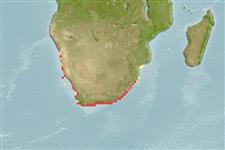>
Eupercaria/misc (Various families in series Eupercaria) >
Sparidae (Porgies)
Etymology: Chrysoblephus: Greek, chrysos = golden + Greek, blepo, blepharizo = to watch (Ref. 45335).
More on author: Valenciennes.
Environment: milieu / climate zone / depth range / distribution range
Ecologie
marien demersaal; standvastig; diepte 20 - 50 m (Ref. 28016). Subtropical; 22°S - 35°S
Southeast Atlantic: known only from the Cape to Natal in South Africa.
Lengte bij maturiteit / Grootte / Gewicht / Leeftijd
Maturity: Lm 30.0 range ? - ? cm
Max length : 75.0 cm TL mannelijk / geslacht onbekend; (Ref. 3198); common length : 50.0 cm TL mannelijk / geslacht onbekend; (Ref. 3507); max. gepubliceerd gewicht: 5.8 kg (Ref. 40637)
Dorsale stekels (totaal): 11 - 12; Dorsale zachte stralen (totaal): 10-11; Anale stekels 3; Anale zachte stralen: 7 - 9. Occasionally with darker crossbars. Adults males with a big hump on forehead.
Inhabits shallow coastal waters. Feeds on crustaceans, mollusks, worms and small fishes (Ref. 5213). Good food fish. Sold fresh in markets. It is parasitised by the monogenean Anoplodiscus cirrusspiralis on the fins and body surface (Ref. 124057).
Levenscyclus en paargedrag
Maturiteit | Voortplanting | Paaien | Eieren | Fecunditeit | Larven
Smith, J.L.B. and M.M. Smith, 1986. Sparidae. p. 580-594. In M.M. Smith and P.C. Heemstra (eds.) Smiths' sea fishes. Springer-Verlag, Berlin. (Ref. 3198)
Status op de Rode Lijst van het IUCN (Ref. 130435)
Gevaar voor de mens
Harmless
Gebruik door de mens
Visserij: commercieel
Meer informatie
ReferentiesAquacultuurAquacultuurprofielKweeklijnenGeneticaElectrophoresesErfelijkheidZiektesVerwerkingNutrientsMassaconversie
Tools
Speciale rapporten
Download XML
Internetbronnen
Estimates based on models
Preferred temperature (Ref.
123201): 15.1 - 24.9, mean 23.7 °C (based on 11 cells).
Fylogenetische diversiteitsindex (Ref.
82804): PD
50 = 0.5156 [Uniqueness, from 0.5 = low to 2.0 = high].
Bayesian length-weight: a=0.02692 (0.01424 - 0.05086), b=3.00 (2.84 - 3.16), in cm total length, based on LWR estimates for this species & Genus-body shape (Ref.
93245).
Trofisch niveau (Ref.
69278): 3.7 ±0.54 se; based on food items.
Weerstandsvermogen (Ref.
120179): laag, minimale populatieverdubbelingstijd 4,5-14 jaar (Preliminary K or Fecundity.).
Fishing Vulnerability (Ref.
59153): Moderate to high vulnerability (50 of 100).
